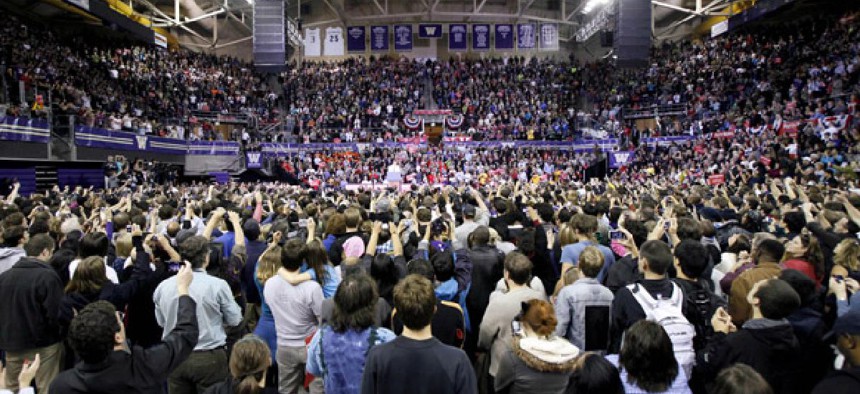Young Voters Disappointed in Obama
After voting for 'hope' and 'change' in 2008, many young people are upset with the president's performance.
When you look back at Barack Obama’s 7-point victory over John McCain in 2008, think of a four-legged stool. Obama needed each leg to support his candidacy. One leg was independent voters (29 percent of the vote); they chose Obama over McCain by 8 percentage points, 52 percent to 44 percent. The second leg was young voters, ages 18-29 (18 percent of vote); they broke for Obama by 34 percentage points, 66 percent to 32 percent. The third leg was Latinos (9 percent); they favored Obama by 36 points, 67 percent to 31 percent. And, finally, African-Americans (18 percent) backed Obama by 91 percentage points, 95 percent to 4 percent. To win reelection, Obama doesn’t need to match those performances, unless he dramatically underperforms with other demographic groups. But he needs to get relatively close to them to build a sufficient popular-vote cushion to assemble 270 electoral votes.
Let’s focus for now on just one leg of the stool, the young voters. Visit any college campus today, and you are likely to sense a lack of passion and energy for Obama. It’s far from clear that he can reproduce the unusually strong turnout among younger voters that he sparked in 2008 or match the 66 percent performance level he achieved then. The data back up the doubts. Gallup tracking surveys in January and February recorded Obama’s job-approval rating at 52 percent and 54 percent, respectively, among 18-to-29-year-olds. The polling suggests he would win the majority of the youth vote, but not anything close to 66 percent. As with other key voter groups, Obama’s numbers with young Americans are better than they were last fall, when his approval ratings among that sector were typically in the mid-to-high 40s. The pattern is a common theme across so many voter groups: Obama is doing better, but his gains aren’t enough to put him close to 2008 levels.
You may have noticed that I tend to focus on job-approval numbers rather than trial-heat figures from candidate matchups. Historically, when you have a president seeking reelection, the approval ratings for that incumbent are better measures of voter support than the trial-heat figures. When an incumbent is running, the election is usually a referendum on that person rather than a choice between two people.
Over the years I’ve found the Democracy Corps, a group started by Democratic pollster Stan Greenberg and the indescribable James Carville, to be a source of enormously valuable survey research and focus-group findings. Unquestionably, Democracy Corps is a public-opinion and research-and-development tool for the Democratic Party. Under tax laws, the group is required to release much of its findings, allowing the rest of us to have access to some really high-quality data. Republicans have now formed their own version of the Democracy Corps with Resurgent Republic, headed by veteran Republican strategist Ed Gillespie and longtime pollster Whit Ayres. Resurgent Republic frequently has other pollsters conduct research projects as well. This week it released a polling memo from Gillespie and Ed Goeas, the lead partner in the Tarrance Group, one of the GOP’s top polling firms. The memo was based on focus groups with Generation Y voters (ages 23-30) in Raleigh, N.C., and Columbus, Ohio. Only independent voters in that age cohort who were undecided on the generic presidential ballot test were included in the focus groups. This limited participation in the group to the true fence-sitters, as opposed to those whose votes in the fall are pretty predictable.
According to the memo from Goeas and Gillespie, “If these groups are representative of this demographic at large, it will be a tall task to counter the disillusionment many feel due to a pattern of overpromising and underdelivering.” They continued, “It is important to note that young voters’ ongoing frustration does not mean they will outright abandon Obama, as was evident in the Ohio groups, but it should call into question their reliability to turn out for him this November, barring any changes.”
These observations, though obviously from partisan Republicans, mirror what I’ve sensed in visiting a half-dozen campuses across the country so far this year: disappointment and disillusionment. In most cases, however, young voters are not to the point of abandonment.
The Republican firm also found that “young voters were decidedly unhappy with the direction of the country” and, “overall, both young voter groups did not think the national economy is getting better.” Perhaps a better way of saying it is that “their economy” is not doing better. This sense leads to a fourth key finding: “Underemployment is a reality among these 23-to-30-year-olds, and they aren’t happy about it.” Several young people mentioned student loans. Another study last week found that student-loan debt in the country now exceeds credit-card debt, something that I find astounding. Finally, Gillespie and Goeas said, “These voters were disillusioned with President Obama, and the discussion of ‘hope’ and ‘change’ triggered a cynical reaction.”
Obama has some of the best political minds in the Democratic Party, and I doubt that any of these findings are revelations to them. It’s safe to assume that the president, the White House, and his campaign are looking for ways to deal with this problem. They will do the same with other challenges in other key legs. Obama’s situation is better than it was, but the stool is still shaky.



